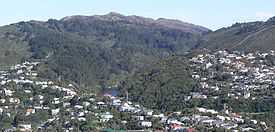Zealandia (wildlife sanctuary)
| Zealandia | |
|---|---|
| Karori Wildlife Sanctuary | |
|
Zealandia on the edge of suburban Wellington | |
| Type | Wildlife sanctuary |
| Location | Wellington, New Zealand |
| Coordinates | 41°17′27″S 174°45′12″E / 41.290817°S 174.753377°E |
| Area | 225 hectares (560 acres) |
| Created | 1999 |
| Operated by | Karori Sanctuary Trust |
| Open | All year around except 25 December |
| Website | http://www.visitzealandia.com/ |
Zealandia, formerly known as the Karori Wildlife Sanctuary,[1] is a protected natural area in Wellington, New Zealand, where the biodiversity of 225 ha (just under a square mile) of forest is being restored. The sanctuary was previously part of the water catchment area for Wellington, between Wrights Hill (bordering Karori) and the Brooklyn wind turbine on Polhill.
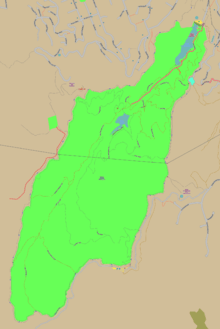
Most of New Zealand's ecosystems have been severely modified by the introduction of land mammals that were not present during the evolution of its ecosystems, and have had a devastating impact on both native flora and fauna. The sanctuary, surrounded by a pest-exclusion fence, is a good example of an ecological island, which allows the natural ecosystems to thrive by minimising those introduced pressures.
The sanctuary has become a significant tourist attraction in Wellington and is responsible for the greatly increased number of sightings of species such as tui and kākā in city's suburbs.
The sanctuary has inspired a raft of similar projects throughout New Zealand, with predator-proof fences now protecting the biodiversity of many other areas of forest. Examples include the 7.7 hectare lowland podocarp forest remnant of Riccarton bush/ Putaringamotu, the 98 hectare Bushy Park and, the 3500 hectare Maungatautari Restoration Project enclosing an entire mountain.
History
Historically about 60% of the Wellington region was covered with broadleaf forest. Karaka, kohekohe, ngaio and nikau trees were common but there were also rata, rewarewa and tawa with occasional podocarps like kahikatea and rimu.[2] The whole sanctuary valley was covered with this sort of forest until European settlement of the area and the large fires in 1850 and 1860 that cleared the land to be used for farming. The lower reservoir, retained by an earth dam, was completed in 1878.[3] Parts of the area continued to be farmed up until 1906 when the remaining catchment was purchased for the water works.[3] The upper reservoir, retained by a concrete gravity arch dam, was completed in 1908.[4] From this point, as the whole valley was a protected water catchment area for Wellington city, the slopes were revegetated with introduced trees and the native forest also began regenerating. The upper dam was decommissioned as a reservoir about 1991, the lower one in 1997.[3]
The "Natural Wellington" project identified the reservoir catchment as having special significance because it is a large self-contained habitat suitable for a wide variety of native plants and animals. In 1993 a feasibility study was carried out by the Wellington regional and city councils and after public consultation in 1994 the idea of a sanctuary was given the go-ahead. The Karori Wildlife Sanctuary Trust was formed in mid 1995 to implement the proposed 'mainland island' wildlife sanctuary.[5][6]
Pest-exclusion fence

The most crucial aspect of the sanctuary is a pest-exclusion fence, designed to exclude fourteen species of non-native land mammals ranging from deer to mice, which encircles the 8.6 km perimeter of the Sanctuary.[7] Construction of the fence was completed in late 1999 and all mammalian pests within the perimeter were then eradicated over a nine-month period. This predator-proof fence is of great conservation significance, being a world first.[8]
Species to be excluded by the fence
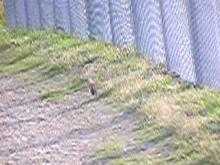
The fence design was arrived at after trials with the various species to be excluded.[9] Its main features are a small mesh size (to exclude animals down to the size of a mouse), a curved top-cap (to prevent animals climbing over) and an underground foot (to prevent animals burrowing underneath).[7]
-

Mesh size
-

Top cap detail
-

Footer

In terms of its meeting conservation goals the sanctuary has met with considerable success due to the design of the perimeter fence. The fence and ongoing monitoring have successfully kept the sanctuary free of all but the smallest species - the house mouse. It is thought that small defects in the fence mesh (damaged during construction) allowed mice to re-enter the sanctuary. Modifications to the fence have been considered in an attempt to permanently exclude mice, but meanwhile mouse numbers are monitored and controlled. There have been occasional breaches of the fence by weasels and rats, these occasional incursions are not unexpected (for example resulting from storm damage bringing trees down upon the fence), and are picked up by on-going monitoring with tracking tunnels.[10][11]
Restoration

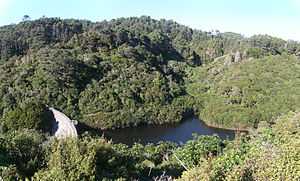
The flora and fauna in the sanctuary is recovering from its pre-managed degraded state. Although the original primary forest has been regenerating since 1906, it is still only in the early stages of succession with small hardy trees such as mahoe dominating. Members of the original flora that are missing from the site, or rare, include large podocarp species such as rimu, matai, miro, kahikatea, and totara, are being re-established. Northern rātā has also virtually disappeared from the valley and a number of seedlings have been planted. A wide variety of native trees, of benefit to native fauna, is already present including a mature colony of the New Zealand tree fuchsia, Fuchsia excorticata.
Species
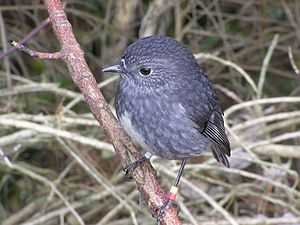
- Native birds that have been released in the sanctuary since 2000 include:
- Bellbird, New Zealand (Korimako) (Anthornis melanura)
- Brown teal (pateke) (Anas chlorotis) (4 pair released 2000-11-03)
- Kākā, North Island (Nestor meridionalis) (3 released 2002-08-24)
- Kākāriki, red-fronted parakeet (Cyanoramphus novaezelandiae) (23 released 2010-July-02)
- Little spotted kiwi (kiwi pukupuku) (Apteryx owenii) (20 released 2000-07-04)
- Pigeon, New Zealand (kererū) (Hemiphaga novaeseelandiae)
- Robin, North Island (toutouwai) (Petroica longipes) (40 released 2001-05-11)
- saddleback, North Island (tieke) (Philesturnus carunculatus rufusater) (39 released 2002-06-16)
- Scaup, New Zealand (papango) (Aythya novaeseelandiae) (1 pair released 2002-05-03)
- Stitchbird (hihi) (Notiomystis cincta) (30 released 2005-02-17)
- Takahē, South Island (Porphyrio hochstetteri) (2 released 2011-01-28)
- Tomtit, North Island (miromiro) (Petroica macrocephala toitoi)
- Weka, North Island (Gallirallus australis) (4 pair released 2000-06-16)
- Whitehead (popokatea) (Mohoua ochrocephala)
- Other native animals that have been released since 2000 include:
- 70 tuatara, Sphenodon punctatus, from Stephens Island were released into the Sanctuary in December 2005.
- 100 giant weta
- 21 Maud Island frogs (2006)
- Other native species that are naturalised without needing transfers from outside the area include:
- Birds
- Fantail, North Island, (piwakawaka) (Rhipidura fulginosa placabilis)
- Falcon, New Zealand, (kārearea) (Falco novaeseelandiae)
- Grey warbler, New Zealand (riroriro) (Gerygone igata)
- Morepork (ruru) (Ninox novaeseelandiae)
- Silvereye (tauhou) (Zosterops lateralis)
- Shining cuckoo (pipiwharauroa)
- Tui (Prosthemadera novaeseelandiae)
- Reptiles[12]
- Common gecko (Hoplodactylus maculatus)
- Forest gecko (Hoplodactylus granulatus)
- Brown skink (Oligosoma zelandicum)
- Common skink (Oligosoma nigriplantare)
- Copper skink (Cyclodina aenea)
- Ornate skink (Cyclodina ornata)
- Birds
See also
References
- ↑ "Wildlife reserve our new Zealandia". The Dominion Post (Fairfax New Zealand). 3 December 2008. Retrieved 1 October 2010.
- ↑ Bain, Helen (November 2006). "Natural Capital". Forest & Bird (Royal Forest and Bird Protection Society of New Zealand Inc.) (322): 33–35. ISSN 0015-7384.
- ↑ 3.0 3.1 3.2 New Zealand Historic Places Trust. "Lower Karori Dam". The Register. New Zealand Historic Places Trust. Retrieved 30 May 2011.
- ↑ "The New Reservoir". Evening Post LXXV (62): 3. 13 March 1908.
- ↑ Lynch, Jim (February 1995). "Back to the Future". Forest & Bird (Royal Forest and Bird Protection Society of New Zealand Inc.) (275): 12–19. ISSN 0015-7384.
- ↑ Lynch, Jim. "Jim's story: the founding of Karori Sanctuary Trust". www.visitzealandia.com. Karori Wildlife sanctuary Trust. Retrieved 29 May 2011.
- ↑ 7.0 7.1 "Zealandia Karori Sanctuary Wellington New Zealand Our Fence". Karori Sanctuary Trust website. Karori Wildlife Sanctuary Trust. 2011. Retrieved 20 February 2011.
- ↑ David Attenborough (November 2000). State of the Planet. BBC Natural History Unit. Retrieved 2011-07-15.
- ↑ Karori Wildlife Sanctuary Trust (1999-11-01). "Pest Eradication - main stage complete" (PDF). Press release 1 November 1999. Karori Wildlife Sanctuary Trust. p. 3. Retrieved 14 Jul 2011.
remove ... (possums, norway rats and ship rats, mice, hedgehogs, wild cats, rabbits, hares, stoats, weasels, ferrets, goats, pigs and fallow deer)
- ↑ McIntosh-Ward, Nancy (2004-07-09). "Karori Wildlife Sanctuary Biosecurity Programme Detects Weasel". Press releases. Karori Wildlife Sanctuary Trust. Retrieved 2011-07-15.
- ↑ "Sanctuary showdown: intruder apprehended". Press releases. Karori Wildlife Sanctuary Trust. 2008-02-22. Retrieved 2011-07-15.
- ↑ Romijn, Richard (2004-12-22). "More species of lizards found in Karori Wildlife Sanctuary". Press releases. Karori Wildlife Sanctuary Trust. Retrieved 2011-07-15.
External links
| Wikimedia Commons has media related to Karori Wildlife Sanctuary. |
- News
Coordinates: 41°17′39.75″S 174°45′0.09″E / 41.2943750°S 174.7500250°E
